Growth Driven Web Design: The Future of Web Development is Already Here
A majority of the buyers and sellers in any market have partially or completely shifted to e-commerce solutions where the customer places an order online, the sellers get in touch in real-time, they share the requirements and available products, and eventually, the entire trade takes place without having a single person to get up from his couch.
If you are one of such sellers who have shifted or are thinking about shifting their business online then do pay attention to this article. This article can make a huge difference in your future operations.
How are you going to trade online?
Two options, either you use another e-commerce platform like Amazon or Alibaba or you build your own platform in the form of a website. We recommend building your own e-commerce website because this is going to help you create your own brand in the future.
How should your platform be designed?
If you are aware of the basics of web development, here are two types of website development concepts that are followed.
A. Traditional web design
B. Growth-driven web design
And which one should you go for or what even are these things? Do not worry. Let us explain.
Traditional web design: Traditional approach for web development is that an organization gets its website developed. They share their requirements and ideas for their website with the developer and after a long period of hefty coding of 3-4 months, the company gets a website. Optimizations are made during the trial test and finally, the website is made live and launched.
Growth-driven design: Growth-driven design is a more modern approach towards web development. The basics are the same that a business contacts a web developer and shares ideas for their website. The developer creates a website and then there is a trial testing period and the website is launched.
But the primary difference arises after the website is launched. A traditionally developed website is optimized and then is left as such for a cycle of 2-3 years to complete when the business finally decides that it needs a new website and the whole process starts over again. What a growth-driven development approach does is that the process of improvements does not need a 2-year cycle to complete.
A continuous design-test-and-implement strategy is followed. Real-time data is regularly gathered from the market, changes are induced on-and-off and the responses of the users are monitored. These analytics are then used for further improvements and this cycle iterates.
Development of Growth-driven Strategy
The growth-driven strategy is not something that has been developed by the developers. In fact, it originated over the years after the inculcation of concepts from sales, marketing, and business management. Consequently, the growth-driven design is more cohered to business objectives in its fundamentals.
Digging a little into these fundamentals is important if you are looking to get your website developed because your business deserves the best of all decisions.
The Agile Strategy
The Agile concept primarily comes from software development where the developers interact on a step-by-step basis with the business to satisfy their needs by taking their input on each and every feature and option on the application.
I.) This helps to avoid conflicts and confusion that may arise during the app development just because of a misunderstanding of the business’s intentions.
II.) The digital world is continuously changing and new improvement possibilities are created every passing day.
So, are you going to make a list of all of those improvements for 2 long years and then integrate them into your website? Certainly not. You would want that if an optimization opportunity arises, you should be the first one to do it so that you do not lose any business.
Teaching elephants to Dance
Rosebeth Moss Kanter has argued in her book ‘Teaching Elephants to Dance’ (1989) that today’s ‘corporate elephants’ need to learn to dance as nimbly and speedily as mice if they are to survive in an increasingly competitive and rapidly changing world.
This is an increasingly popular concept in business studies that a business should be flexible to adapt to changes urgently so that it does not lag in the market competition. But how do you think of doing this when your website has to wait for 2 long years before it can include a two-line-code optimization.
If GDD is such a brainy thing, why do businesses still opt for traditional websites?
A very good question indeed!
Thing is, not all businesses are up-to-date with the latest information and developments as you are right now after reading this article. The speed of change in the digital world has multiplied to such an extent that it is impossible to even for a marketer to keep track of all the latest concepts. So:
a.) People may not have proper awareness about the potential they can unlock by simply changing how they are operating their website.
b.) Second, businesses need approvals from senior management to take such big steps as building their website or renewing it. It is a lot easier to get such approvals once in a while rather than every month. So, to avoid the hassle of such extensive reporting, you opt for traditional web design.
c.) Traditional web design needs a one-time investment of money and workforce and you get a ready website. GDD demands a permanent integration of a new function that can maintain the website or permanent outsourcing which is perceived to drain all of their funds.
What are the hassles of GDD and what would I get in return?
You need to understand that Growth-driven design demands your attention and allocation of resources on a permanent basis.
Your web development and marketing teams will be consistently interacting and sharing ideas and feedback with each other and this loop will iterate infinitely.
Let’s consider an example here: Say we are talking about the color of your call-to-action button. Keeping in mind the overall color scheme of your site, you can choose among a red, a green, and an orange-colored CTA.
Now you are not sure which color to go for or even if there is a difference in customer’s behavior by changing the color. You are in a fix.
Why not ask the customer himself? Select a period of 3 weeks and change the color of the CTA every week and keep all remaining factors such as marketing campaigns constant so that you know that all changes in the CTA metrics are solely because you changed the color of the button.
Analyze the results after 3 weeks and whichever performed the best gets to stay on your site.
There are infinite possibilities with what market experiments you can perform with GDD and gain insights that are specific to your business and not some overall industry trend analysis.
Ask the surveys!
Here are some results of case studies conducted by Growth-driven design that precisely suggest that GDD performs a lot better and helps drive growth, exactly what it claims for its name.
Head to Smart Marketing if you need more assurance on the metric of GDD.
Follow up another case study of a software company Aptify here who almost doubled their lead generation from their website in just 2 months of their web redesign.
Should you consider GDD for your website?
Seems unnecessary after all the discussion.
Our recommendation? Absolutely yes!
GDD is the only possibility for you to actively take up your market information and continue growing by using the precise insights you obtain from your own platform.
Contact us for more information on Growth-driven websites. We will be very glad to hear what you have to say about this.
Contact our team if you need to get your site developed. We will make sure you receive quality industry-standard work from our professional developers and marketers.
Merry Christmas and Happy Web Designing!
Still have your concerns?
Your concerns are legit, and we know how to deal with them. Hook us up for a discussion, no strings attached, and we will show how we can add value to your operations!



